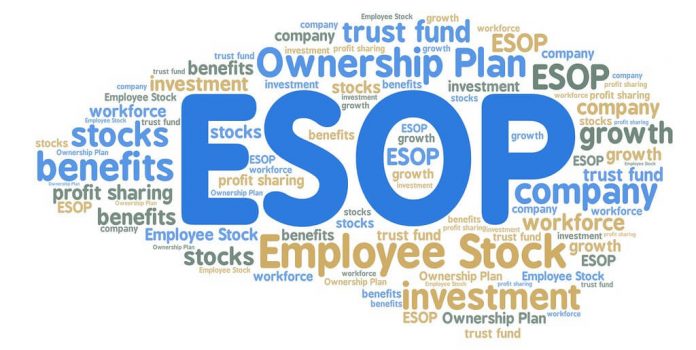This article is written by Sneha Asthana pursuing Diploma in Business Laws for In-House Counsels from LawSikho.
Table of Contents
Introduction
Employee Stock Ownership Plans can make you rich if you know how they work. ESOP is one of the reasons why employees, drivers, masseuses, warehouse workers, etc. have become millionaires. Many of these millionaires are created by renowned companies like Google, Facebook, Infosys, Zomato, Paytm, Oyo, etc.
Employee Stock Ownership Plan refers to the stock options given to the employees of the company providing them with an ownership interest in the organization. It is mostly given by start-up companies that are still in a nascent stage having a limited financial operation or are cash-strapped. This is, essentially, a right given to the employees to acquire the shares of the company at a predetermined price.
While the main rationale behind introducing such a plan is employee welfare, it has evident benefits for the employer as well. This article focuses on understanding what the Employee Stock Ownership Plan is, how it works, its effect on employees, employers, and the workings of it in both unlisted and listed companies.
Why are ESOPs popular?
Employee Stock Ownership Plan is a plan in which the company offers its stock options to its employees at nominal or discounted prices. This is, essentially, a right given to the employees to acquire the shares of the company at a predetermined price. This plan is generally given to employees in salary packages or bonus plans etc., and is often used as an incentive mechanism. It is mostly given by start-up companies that are in a nascent stage having a limited financial operation or cash-strapped companies.
The definition of the same has been incorporated in both the Companies Act, 1956 and 2013. Section 2, Clause 15A of the 1956 Act covers the definition of Employee Stock Option and Section 62 of the 2013 Act incorporates further provisions enabling such a plan. ESOPs are also guided by the Securities and Exchange Board of India.
Introducing such plans in a company has a two-fold benefit. Firstly, it gives employees great compensation for the work they put in. History has witnessed several employees of companies becoming millionaires because of such plans. Secondly, it helps the employers in retaining high-quality employees by offering them such shares in a phased-out manner which ensures such employees stay loyal to the company for long periods.
One of the most recent landmark ESOP was developed by Infosys, the global leader in the digital and consulting industry, in the year 2019. The company declared to offer over 5 crore shares to its employees. Such an offer was directly linked to its strategy of attracting the key talent of the IT population and rewarding the already present employees based upon meritocracy. This move was lauded globally as it was one of the firsts for a company to offer shares of such a significant amount to its employees. Through this move, Infosys showed the world the great lengths it can go to reward its employees. Shortly after, in the year 2020, it granted 37,88,260 shares to some of its Key Managerial Persons (KMP) and eligible employees under the 2019 declaration.
How does the ESOP scheme usually work?
The ESOP scheme usually works according to two dates i.e. the vesting date and the exercise date. It is only after imposing a lock-in period first, which generally lasts a few months, can the employees begin to realize and exercise their rights.
The vesting date
The vesting date is the date on which the company opens the option of buying the shares to the employee. It could also be defined as the date on which the employee realizes his rights to buy the shares. This date is given to an employee after a particular lock-in period. It is just a mere option and no obligation is attached to it. The vesting period can extend more than a day up to even a month or more. These stock options can also be given to an employee in a phased manner thereby giving him/her different vesting dates for each section of shares.
For example; A, an employee, could be given 100 shares in a phased manner, with vesting dates one year apart for 50 shares each.
The exercise date
The exercise date is the date on which the employee buys the shares. Since the vesting date does not make it mandatory for the employee to buy the shares immediately, the employee can lapse the option of exercise at the time for reasons such as the prevalent market price/fair market value of the shares could be lower than the predetermined price offered to the employee. Buying the shares at such a time would only cause losses to the employee and therefore, he may decide to skip the right to exercise his option of buying the shares.
Taxability of Employee Stock Ownership Plans
ESOP is taxed at two instances:
-
As perquisites
Where they are treated as perquisite and tax is deducted at source. This tax is only deducted when the option is exercised after the vesting period and the shares are sold. Until before the amendment made in the Budget, 2020, this tax was supposed to be paid immediately after the shares had been exercised. However, this seemed to have posed problems for companies with low financial problems causing cash flow disturbances. Post 2020 Budget amendment, companies were given certain dates on which they had to pay such tax i.e. 4 years from the end of the year in which the shares were sold, on the date of sale of shares, or on the day the assessee ceases to be an employee.
-
Capital gains
Where they can be taxed as capital gains, which is essentially the difference between the sale value and the fair market value, from employees who have sold the very shares at a profit.
ESOP in unlisted companies
The Companies Act, 2013 and (Share Capital and Debenture) Rules state the provisions for granting of ESOP to employees of unlisted companies. Section 62 (1) (b) of the 2013 Act states that the company can create the ESOP scheme only pursuant to a Special Resolution. Rule 12 of the (Share Capital and Debenture) Rules lays down the procedure of creating such a scheme and the protocols to follow for it. The following are the steps to create an ESOP scheme:
-
Recognizing employees
According to Rule 12 of the (Share Capital and Debentures) Rules, 2014, private limited companies can only issue ESOPs to employees which are defined as:
- Permanent employees residing in or out of India
- Directors, regardless of whole-time or not but excluding an independent director.
- Employees of a subsidiary or holding company residing in or out of India except for a promoter or a director who directly or indirectly holds more than 10% of the equity shares.
However, a start-up company, recognized by the Department for Promotion of Industry and Internal Trade (DPIIT), is exempted from the restriction of promoters and directors for a period of 5 years from the date of its incorporation or registration.
-
Special resolution
After recognizing ‘employees’ as per Rule 12, the shareholders of the company are required to approve the Employee Stock Ownership Plan through a special resolution in the general meeting. The company is also required to attach certain disclosures in the notice given for the approval of the ESOP. Some of those disclosures are:
- Total number of shares granted
- Recognized classes of employees
- Lock-in period
- Vesting period
- Vesting date
- Exercise date
- The maximum number of options to be granted per employee.
- Exercise dates and periods in the event of termination, resignation, etc.
-
Separate resolution
The approval of shareholders in the event of ESOP being granted to a subsidiary or holding companies or ESOP equal to or exceeding 1% of the issuing capital being granted to employees has to be taken by way of a separate resolution.
-
Compliance
Rule 12 also imposes certain compliance on the company, such as:
- Maintain a register of Employee Stock Options in Form No. SH.6 and shall enter the particulars of option granted under Section 62 (1) (b) of the Act.
- Maintain the above the registered office of the company or such other place as the board of directors of the company may decide.
- The entries in the register shall be authenticated by the company secretary of the company or by any other person authorized by the board of directors for this purpose.
-
Other duties
Rule 12 also ensures certain measures and guidelines that the company has to follow:
- Rule 12 Sub Rule 5: The company may modify or change certain terms of the ESOP by way of a Special Resolution provided such changes are fair to the employees.
- Rule 12 Sub Rule 6: This rule allows the company to give a minimum period of 1 year between the grant of options and the vesting period. It allows the company to determine a lock-in period. It also states that no employee shall be allowed a right to vote or receive any dividend on the stock options until shares are issued on the exercise of the option.
- Rule 12 Sub Rule 7: This rule talks about the conditions in which the amount, if any, paid by the employee can be forfeited or refunded.
- Rule 12 Sub Rule 8: Under Rule 8, the transferability of such options to any other person is restricted. However, upon the death of the employee, the right can be exercised by legal heirs and nominees.
- Rule 12 Sub Rule 9: This rule includes few other aspects, in addition to the above-I h mentioned disclosures that have to be disclosed in the Director’s Report for the year by the Board of Directors.
ESOP in listed companies
An ESOP scheme for a listed company has been demarcated very narrowly from that of an unlisted company, by the SEBI guidelines. An ESOP Scheme for a listed company is called Employee Stock Purchase Scheme (ESPS).
Rule 2 Sub Rule 4 of the SEBI Guidelines defines Employee Stock Purchase Scheme as a scheme where the company offers shares to its employees as a part of a public issue or otherwise. A company can only do so when it has been listed.
The line of difference between the Employee Stock Ownership Plan and the Employee Stock Purchase Scheme is very thin. The major difference lies in the issue of shares. While ESOP grants a right to the employees to acquire the shares of the company at a predetermined nominal price without attaching any obligation to do the same, ESPS does not give a right to the employees but allows the employees of the company to purchase the shares at a discounted price at a predetermined rate. Such a discount can go as low as 15% from the market price of the shares. A purchase of shares, under an ESPS, can normally be bought from the after-tax money the employees receive However, unlike ESOP, which is more of a remuneration technique, ESPS is a scheme wherein the employees contribute to the plan by accepting deductions in their payroll between the offer date and the purchase date thereby saving for such a purchase.
Under the SEBI Guidelines, all other aspects of ESPS include:
- Essential action of purchasing shares
- The procedure of issuing such shares
- The compliance
- Resolutions
- Eligibility
- Duties of the Board etc. remain the same as that of the ESOP Scheme.
Conclusion
Companies, after following the respective statutes and guidelines, can offer the kind of scheme that suits the best for their company. Clear distinction for a particular scheme attached to a particular company has not been given which could give companies a chance to play around with combinations of different kinds of Employee Stock Ownership Plans. While each scheme has its advantages and disadvantages, it depends entirely on the companies’ performance financially and operationally to decide the kind of scheme that would be best suited. Given today’s scenario of the pandemic which has done serious damage to small companies, granting out ESOPs could be a viable option for them.
However, ESOPs have their downfalls too. While the entire article focuses on what ESOP is and its usefulness, a mention of its gray areas is inevitable. ESOPs have also been under the radar for being quite disadvantageous to employees in terms of reduced morale because the companies that couldn’t meet the expected profitability were not able to reward their employees, high cuts from salaries of the employees initially seemed off-putting as well. One of the major concerns that arise today is the struggle employees are taking to exercise these options in such a volatile market. While granting out ESOPs could appear a safe bet as financial operations remain on the down low, exercising the options in today’s extremely unpredictable market, thanks to the pandemic, has left employees bewildered. The need for accurate and informed personnel for administration, legal compliance, and financial operations has further grown exponentially to ride out the ESOP boat smoothly for both the company and its employees.
References
- https://taxguru.in/income-tax/employee-stock-option-plan-unlisted-company.html
- https://taxguru.in/income-tax/taxability-esop-income-tax-act-1961.html#:~:text=Yes%2C%20in%20 F.Y.,to%20credit%20of%20Central%20Govt.
- https://www.photonics.com/Articles/Vesting_and_Exercising_/a28183
- https://cleartax.in/s/esop
- https://www.financialexpress.com/money/employee-stock-option-plan-all-you-need-to-know-about-esop-and-its-tax-implications/1162110/
- https://www.mondaq.com/india/shareholders/948746/eligibility-and-procedure-for-issuance-of-esops-by-unlisted-private-limited-companies#:~:text=As%20per%20Section%2062%20(1,procedure%20 prescribed%20under%20the%20 Rules.
- https://www.lexorbis.com/eligibility-and-procedure-for-issuance-of-esops-by-unlisted-private-limited-companies/#:~:text=Under%20the%20side%20 Rules%2C%20ESOPs,and%20unlisted%20private%20limited%20company.&text=a%20director%20who%20 either%20 himself,equity%20shades%20of%20the%20company.
- https://www.corporateprofessionals.com/types-of-esops/
- https://registrationseva.com/esopsandespsforlistedcompany/
- https://www.investopedia.com/terms/e/espp.asp#:~:text=An%20employee%20 stock%20 purchase%20plan%20(ESPP)%20is%20a%20company%2D,date%20and%20the%20purchase%20date.
- https://www.businesstoday.in/moneytoday/stocks/esop-regulations-sebi-income-tax-investors-secondary-market/story/209774.html
- https://www.financialexpress.com/market/infosys-offers-5-crore-shares-to-employees-key-things-to-know-about-performance-based-program/1580940/
Students of Lawsikho courses regularly produce writing assignments and work on practical exercises as a part of their coursework and develop themselves in real-life practical skills.
LawSikho has created a telegram group for exchanging legal knowledge, referrals, and various opportunities. You can click on this link and join:
 Serato DJ Crack 2025Serato DJ PRO Crack
Serato DJ Crack 2025Serato DJ PRO Crack











 Allow notifications
Allow notifications



